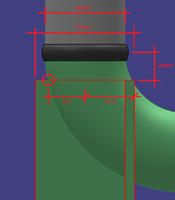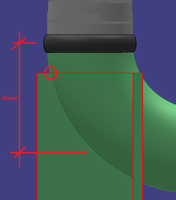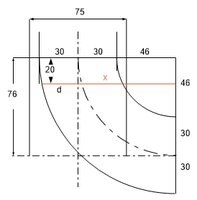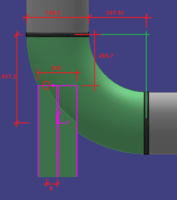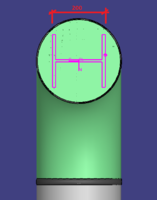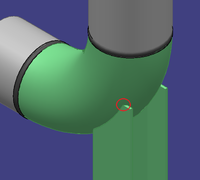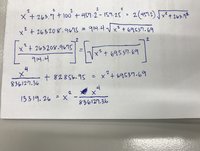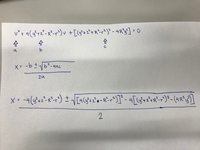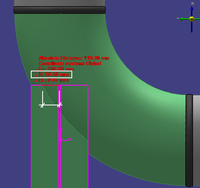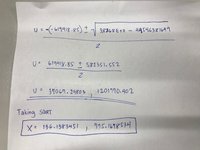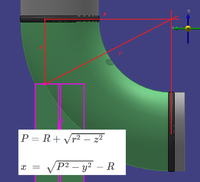Tangent Distance
- Thread starter RJay
- Start date
Dr.Peterson
Elite Member
- Joined
- Nov 12, 2017
- Messages
- 16,821
Please explain in words what you are given and what you want to find. The picture doesn't communicate fully. At the least, it would seem that you would need to know the radius of the arcs, assuming they are circles.
Hi Dr. Peterson. Thank you for the reply.
First, I have an Elbow(object with an arc) and I have a vertical object in rectangular shape.
The center of the rectangular shape is aligned with center of the Elbow.
The distance from the end of the Elbow to the edge of the vertical object is 20mm with 75mm width
The diameter of the Elbow is 60mm.
I wanted to know the distance from the center of the vertical object to the intersection point (the one I encircled).
Basically I want to know the formula on how to get the distance with "???"
Please let me know if you need more information.
By the way, the distance from the edge of Elbow to its center is 76mm
First, I have an Elbow(object with an arc) and I have a vertical object in rectangular shape.
The center of the rectangular shape is aligned with center of the Elbow.
The distance from the end of the Elbow to the edge of the vertical object is 20mm with 75mm width
The diameter of the Elbow is 60mm.
I wanted to know the distance from the center of the vertical object to the intersection point (the one I encircled).
Basically I want to know the formula on how to get the distance with "???"
Please let me know if you need more information.
By the way, the distance from the edge of Elbow to its center is 76mm
Attachments
Dr.Peterson
Elite Member
- Joined
- Nov 12, 2017
- Messages
- 16,821
You still haven't mentioned the radius of the arcs -- the inside and outside radius of the bend itself. Or is one of those the 76 mm measurement?
It appears that the 75 mm measurement doesn't matter.
Here is a picture that shows all the pieces you need:
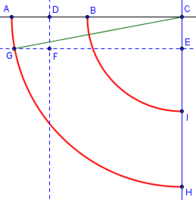
You have AB = 60 mm; DF = CE = 20 mm; and radius AC. You want to find FG.
One way would be to make a coordinate system and write the equation of the circle through A. Another is to use the Pythagorean Theorem on right triangle CEG (where you know radius CG and length CE) to find EG; then subtract EF (= CD) from that.
It appears that the 75 mm measurement doesn't matter.
Here is a picture that shows all the pieces you need:

You have AB = 60 mm; DF = CE = 20 mm; and radius AC. You want to find FG.
One way would be to make a coordinate system and write the equation of the circle through A. Another is to use the Pythagorean Theorem on right triangle CEG (where you know radius CG and length CE) to find EG; then subtract EF (= CD) from that.
Cool! 
Thank you Dr. Peterson for the explanation.
I feel like I've been banging my head against a wall trying to understand this equation but you've explained it well!
Mr. LCKurtz, thank you so much for the illustration. It did help me understand even more.
One more thing, my question may sound basic but how did you get the 46 value? I honestly don't know the radius but based on the illustration radius is 106.
Thank you Dr. Peterson for the explanation.
I feel like I've been banging my head against a wall trying to understand this equation but you've explained it well!
Mr. LCKurtz, thank you so much for the illustration. It did help me understand even more.
One more thing, my question may sound basic but how did you get the 46 value? I honestly don't know the radius but based on the illustration radius is 106.
Dr.Peterson
Elite Member
- Joined
- Nov 12, 2017
- Messages
- 16,821
I believe the 46 comes from guessing that the 76 you gave for "the distance from the edge of Elbow to its center" means the radius of the centerline of the elbow. If you don't know any radii for the arcs, then you just can't solve the problem!
Can you please help me find the formula for the second scenario?
I want to find the distance from the center of vertical member to the intersection point which is marked with X.
The center of vertical object is also aligned with the center of the elbow.
I want to find the distance from the center of vertical member to the intersection point which is marked with X.
The center of vertical object is also aligned with the center of the elbow.
Attachments
Dr.Peterson
Elite Member
- Joined
- Nov 12, 2017
- Messages
- 16,821
Let's introduce a coordinate system with origin at the center of the bend, that is, the intersection of the green lines. (It is your failure to show that point, and radii from that center, that made it hard to answer your initial question; your 297.95 here corresponds to the presumed 46 there.)
I'll take x going to the left from there, and y going down, to that both will be positive; the axes will have the usual orientation if you hold your picture upside-down. I'll take z as going toward the viewer.
I'll describe the elbow in terms of the radius of the pipe itself, r = 318.5/2 = 159.25, and the radius of the arc along the center of the pipe, R = 297.95+159.25 = 457.2.
The elbow is part of a torus, which is most easily described in term of cylindrical coordinates; I'll define the distance from the origin in the xy-plane as [MATH]\rho = \sqrt{x^2 + y^2}[/MATH]. Then the equation of the torus is [MATH](\rho - R)^2 + z^2 = r^2[/MATH].
Replacing [MATH]\rho[/MATH] with its definition, the equation in rectangular coordinates becomes [MATH]\left(\sqrt{x^2 + y^2} - R\right)^2 + z^2 = r^2[/MATH].
Now, as I understand it, the point you are interested in has [MATH]y = 263.7[/MATH] and [MATH]z = 100[/MATH]. Plug those into the equation and solve for [MATH]x[/MATH]; what I think you are asking for (your "x") is my [MATH]x - R[/MATH].
The hard part is solving the radical equation. Expanding and simplifying a little, it becomes [MATH]x^2 + y^2 + z^2 + R^2 - r^2 = 2R\sqrt{x^2 + y^2}[/MATH]. To solve that, you need to square both sides, which results in a fourth degree equation. That will be solvable algebraically only with a lot of ugly work. The best thing to do is to solve it numerically.
I don't know what tools you have; I've been surprised that you need help at all, considering that you appear to have some sort of CAD software, but someone should be able to help you use whatever tools you have to solve the equation.
I'll take x going to the left from there, and y going down, to that both will be positive; the axes will have the usual orientation if you hold your picture upside-down. I'll take z as going toward the viewer.
I'll describe the elbow in terms of the radius of the pipe itself, r = 318.5/2 = 159.25, and the radius of the arc along the center of the pipe, R = 297.95+159.25 = 457.2.
The elbow is part of a torus, which is most easily described in term of cylindrical coordinates; I'll define the distance from the origin in the xy-plane as [MATH]\rho = \sqrt{x^2 + y^2}[/MATH]. Then the equation of the torus is [MATH](\rho - R)^2 + z^2 = r^2[/MATH].
Replacing [MATH]\rho[/MATH] with its definition, the equation in rectangular coordinates becomes [MATH]\left(\sqrt{x^2 + y^2} - R\right)^2 + z^2 = r^2[/MATH].
Now, as I understand it, the point you are interested in has [MATH]y = 263.7[/MATH] and [MATH]z = 100[/MATH]. Plug those into the equation and solve for [MATH]x[/MATH]; what I think you are asking for (your "x") is my [MATH]x - R[/MATH].
The hard part is solving the radical equation. Expanding and simplifying a little, it becomes [MATH]x^2 + y^2 + z^2 + R^2 - r^2 = 2R\sqrt{x^2 + y^2}[/MATH]. To solve that, you need to square both sides, which results in a fourth degree equation. That will be solvable algebraically only with a lot of ugly work. The best thing to do is to solve it numerically.
I don't know what tools you have; I've been surprised that you need help at all, considering that you appear to have some sort of CAD software, but someone should be able to help you use whatever tools you have to solve the equation.
Based on the equation this is what I've got and I'm stuck.
I am using a 3D software. Basically I can measure the distance of "x" in the software, however the value is not true to all scenario so I should find out for a formula.
Diameter of Elbow depends on every scenario.
I am creating a program to identify the intersection point (x) so I can place a weld symbol to that point.
I am using a 3D software. Basically I can measure the distance of "x" in the software, however the value is not true to all scenario so I should find out for a formula.
Diameter of Elbow depends on every scenario.
I am creating a program to identify the intersection point (x) so I can place a weld symbol to that point.
Attachments
Dr.Peterson
Elite Member
- Joined
- Nov 12, 2017
- Messages
- 16,821
When you squared the left-hand side, you missed the middle term (you need to "foil" it). So your equation is wrong.
But your work makes me aware that I neglected to follow through on solving the equation, and it turns out I was wrong about needing numerical methods and being unable to find a formula. Because x appears only as x^2, the quartic equation is really a quadratic in disguise, and the quadratic formula can be used.
Here is the equation again:
Squaring both sides (while keeping constants together) yields
This simplifies to
Replace [MATH]x^2[/MATH] with [MATH]u[/MATH] and you have the quadratic equation
Use the quadratic formula to solve for u, then take the square root and you have x. (Take only positive values at each step; hopefully there will be only one such solution.)
But your work makes me aware that I neglected to follow through on solving the equation, and it turns out I was wrong about needing numerical methods and being unable to find a formula. Because x appears only as x^2, the quartic equation is really a quadratic in disguise, and the quadratic formula can be used.
Here is the equation again:
[MATH]x^2 + y^2 + z^2 + R^2 - r^2 = 2R\sqrt{x^2 + y^2}[/MATH]
Squaring both sides (while keeping constants together) yields
[MATH]x^4 + 2(y^2 + z^2 + R^2 - r^2)x^2 + (y^2 + z^2 + R^2 - r^2)^2= 4R^2(x^2 + y^2)[/MATH]
This simplifies to
[MATH]x^4 + 2(y^2 + z^2 - R^2 - r^2)x^2 + [(y^2 + z^2 + R^2 - r^2)^2 - 4R^2 y^2] = 0[/MATH]
Replace [MATH]x^2[/MATH] with [MATH]u[/MATH] and you have the quadratic equation
[MATH]u^2 + 4(y^2 + z^2 - R^2 - r^2)u + [(y^2 + z^2 + R^2 - r^2)^2 - 4R^2 y^2] = 0[/MATH]
Use the quadratic formula to solve for u, then take the square root and you have x. (Take only positive values at each step; hopefully there will be only one such solution.)
Dr.Peterson
Elite Member
- Joined
- Nov 12, 2017
- Messages
- 16,821
What you've found is u, not x.
Just take the square root of the value you get.
Just take the square root of the value you get.
Dr.Peterson
Elite Member
- Joined
- Nov 12, 2017
- Messages
- 16,821
I get the same numerical results when I plug in the numbers and then solve the equation. I also can't see any error in my derivation of the equation.
I think we need another pair of eyes looking at this, to see whatever I'm blind to.
I think we need another pair of eyes looking at this, to see whatever I'm blind to.

